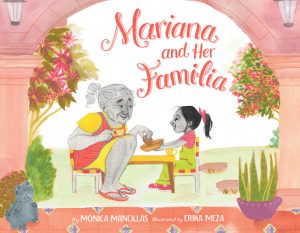 Mariana and Her Familia
Mariana and Her Familia
Written by Mónica Mancillas
Illustrated by Erika Meza
HarperCollins 2022, 32 pp (unpaged)
ISBN: 978-0062962461
Mariana and her mother are crossing the United States-México border to visit Abuela and their extended family. Mariana is hesitant because she has not been to Abuela’s house in many years. At home, there is only Mariana and Mami. But here, there are lots of family members. Mariana knows little Spanish and she feels embarrassed when she utters agualita rather than abuelita. But Abuela knows exactly what to do. She invites Mariana to read Los tres cochinitos, which Mariana recognizes as the story about the three little pigs and the big bad wolf. Then, they make quesadillas and share them with the rest of the family. Now that Mariana feels better, she is ready to give Abuela the gift she brought from the U.S.: a picture of Mariana when she was little. As Abuela walks Mariana to a special wall of family pictures, Mariana understands that she has always belonged to her familia.
This story is particularly relevant to readers who are reconnecting with family after being apart by time and distance. Abuela and Mami represent love and patience. It is very possible that Mami experienced similar fears when she moved to the U.S. Although her experiences and emotions are not the focus of the story, her sense of place, reassurance, and certainty could indicate that she learned how to reconnect and what it means to have a home away from home some time ago. Similarly, Abuela must have gone through a similar journey when Mami moved away. Now Mariana learns from her own experience and from the experiences of prior generations. Since Mariana’s extended family lives, presumably, in a pueblo fronterizo, it is possible that the familia interacts within a monolingual-multilingual continuum; however, that is not addressed in the story. Therefore, Mariana’s bilingual identity could contribute to the creation or expansion of linguistic spaces and practices in the family history; a journey of bringing families, homes, and worlds together.
Erika Meza used watercolor pencil, gouache, and drew from childhood memories of characters, objects, and cantera stone to create the illustrations. Picturebooks that depict skin tone with a gray palette are not common, with the exception of books about sadness or depression, in which the gray tones gradually change to a range of colors like The Color Thief: A Family’s Story of Depression (2015), by Andrew Fusek Peters, Polly Peters, and Karin Littlewood. Countless shades of gray are infused throughout the illustrations creating colorful and warm representations of Mariana’s familia. Interestingly, there are visual instances when the little cousins’ faces look too similar to one another. This observation could elicit important conversations about representation and diversity within families and communities.
Along with her use of gray tones, Meza offers several cues to signal readers that the book might be set in Tijuana, México. For example, the sign on a street vendor’s cart that reads CROC Manuel Zavala, presumably referencing Juan Manuel Zavala, a representative of the Taxis Amarillos in Tijuana, and CROC, a Mexican union federation. Both organizations have advocated for Taxis Amarillos to be able to operate in the San Ysidro border crossing. This reference speaks to the illustrator’s ability to provide a window into the larger socio-political and economic climate of the story.
Mariana and Her Familia can be paired with other picturebooks about grandparents and grandchildren seeking connections while learning languages together like Mango, Abuela, and Me, by Meg Medina and Angela Dominguez (2017), Drawn Together, by Minh Lê and Dan Santat (2018), or Grandpa Across the Ocean, by Hyewon Yum (2021). In these stories, characters’ profound love and desire to keep family together encourage them to build connections through stories, artifacts, and places, despite linguistic and cultural differences.
Mónica Mancillas is an author, musician, and educator, who writes picturebooks and middle grade fiction and non-fiction. She wrote Mariana and Her Familia based on her childhood experiences as a first-generation immigrant, born in Ensenada in Baja California, México. Some of her upcoming projects include the picturebooks The Worry Balloon, illustrated by Betty C. Tang (Roaring Brook Press, 2023) and How to Speak in Spanglish, illustrated by Olivia De Castro (Penguin Workshop, 2023). Her work can be explored at her website.
Erika Meza is a Mexican author and illustrator. She studied graphic design in Tijuana, Mexico and attended the Illustration programme at L’École Nationale Supérieure des Arts Décoratifs in Paris, France. She is the illustrator of the award-winning book My Two Border Towns by David Bowles (2021). Her upcoming projects include the Spanish translation for Nigel y la luna, written by Antwan Eady and illustrated by Gracey Zhang (HarperCollins, 2023), her first author/illustrator picturebook titled To the Other Side (HarperCollins, 2023), the illustrations for The Memory Book, by Louise Gooding (Wren & Rook, 2023), and Stop! That’s Not My Story, by Smriti Prasadam (Simon & Schuster Children’s UK, 2023). Visit her website to learn more about Meza’s work.
María V. Acevedo-Aquino, Texas A&M University-San Antonio
© 2022 by María V. Acevedo-Aquino

